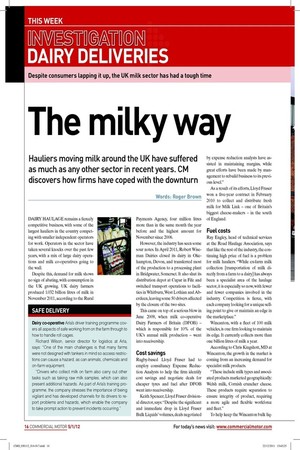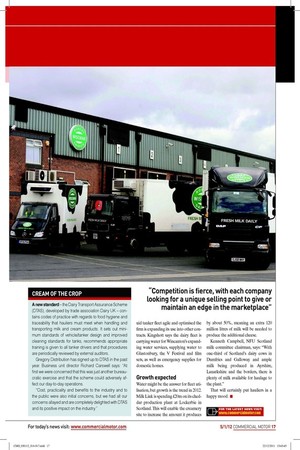DAIRY DELIVERIES
Page 13

Page 14

If you've noticed an error in this article please click here to report it so we can fix it.
Despite consumers lapping it up, the UK milk sector has had a tough time
The milky way
Hauliers moving milk around the UK have suffered as much as any other sector in recent years. CM discovers how firms have coped with the downturn
Words: Roger Brown
DAIRY HAULAGE remains a iercely competitive business, with some of the largest hauliers in the country competing with smaller independent operators for work. Operators in the sector have taken several knocks over the past few years, with a mix of large dairy operations and milk co-operatives going to the wall.
Despite this, demand for milk shows no sign of abating, with consumption in the UK growing. UK dairy farmers produced 1.032 billion litres of milk in November 2011, according to the Rural Payments Agency, four million litres more than in the same month the year before and the highest amount for November since 2006.
However, the industry has seen some sour notes. In April 2011, Robert Wiseman Dairies closed its dairy in Okehampton, Devon, and transferred most of the production to a processing plant in Bridgwater, Somerset. It also shut its distribution depot at Cupar in Fife and switched transport operations to facilities in Whitburn, West Lothian and Aberdeen, leaving some 50 drivers affected by the closure of the two sites.
This came on top of a serious blow in June 2009, when milk co-operative Dairy Farmers of Britain (DFOB) – which is responsible for 10% of the UK’s annual milk production – went into receivership.
Cost savings
Rugby-based Lloyd Fraser had to employ consultancy Expense Reduction Analysts to help the irm identify cost savings and negotiate deals for cheaper tyres and fuel after DFOB went into receivership.
Keith Spencer, Lloyd Fraser divisional director, says: “Despite the signiicant and immediate drop in Lloyd Fraser Bulk Liquids’ volumes, deals negotiated by expense reduction analysts have assisted in maintaining margins, while great efforts have been made by management to rebuild business to its previous level.” As a result of its efforts, Lloyd Fraser won a ive-year contract in February 2010 to collect and distribute fresh milk for Milk Link – one of Britain’s biggest cheese-makers – in the south of England.
Fuel costs
Ray Engley, head of technical services at the Road Haulage Association, says that like the rest of the industry, the continuing high price of fuel is a problem for milk hauliers. “While ex-farm milk collection [transportation of milk directly from a farm to a dairy] has always been a specialist area of the haulage sector, it is especially so now, with fewer and fewer companies involved in the industry. Competition is ierce, with each company looking for a unique selling point to give or maintain an edge in the marketplace.” Wincanton, with a leet of 100 milk vehicles, is one irm looking to maintain its edge. It currently collects more than one billion litres of milk a year.
According to Chris Kingshott, MD at Wincanton, the growth in the market is coming from an increasing demand for specialist milk products.
“These include milk types and associated products marketed geographically: Welsh milk, Cornish cruncher cheese. These products require separation to ensure integrity of product, requiring a more agile and lexible workforce and leet.” To help keep the Wincanton bulk liq uid tanker leet agile and optimised the irm is expanding its use into other contracts. Kingshott says the dairy leet is carrying water for Wincanton’s expanding water services, supplying water to Glastonbury, the V Festival and ilm sets, as well as emergency supplies for domestic homes.
Growth expected
Water might be the answer for leet utilisation, but growth is the trend in 2012. Milk Link is spending £20m on its cheddar production plant at Lockerbie in Scotland. This will enable the creamery site to increase the amount it produces by about 50%, meaning an extra 120 million litres of milk will be needed to produce the additional cheese.
Kenneth Campbell, NFU Scotland milk committee chairman, says: “With one-third of Scotland’s dairy cows in Dumfries and Galloway and ample milk being produced in Ayrshire, Lanarkshire and the borders, there is plenty of milk available for haulage to the plant.”
That will certainly put hauliers in a happy mood. ■
SAFE DELIVERY
Dairy co-operative Arla’s driver training programme covers all aspects of safe working from on the farm through to how to handle roll cages.
Richard Wilson, senior director for logistics at Arla, says: “One of the main challenges is that many farms were not designed with tankers in mind so access restrictions can cause a hazard, as can animals, chemicals and on-farm equipment.
“Drivers who collect milk on farm also carry out other tasks such as taking raw milk samples, which can also present additional hazards. As part of Arla’s training programme, the company stresses the importance of being vigilant and has developed channels for its drivers to report problems and hazards, which enable the company to take prompt action to prevent incidents occurring.”
CREAM OF THE CROP
A new standard – the Dairy Transport Assurance Scheme (DTAS), developed by trade association Dairy UK – contains codes of practice with regards to food hygiene and traceability that hauliers must meet when handling and transporting milk and cream products. It sets out minimum standards of vehicle/tanker design and improved cleaning standards for tanks, recommends appropriate training is given to all tanker drivers and that procedures are periodically reviewed by external auditors.
Gregory Distribution has signed up to DTAS in the past year. Business unit director Richard Carswell says: “At first we were concerned that this was just another bureaucratic exercise and that the scheme could adversely affect our day-to-day operations.
“Cost, practicality and benefits to the industry and to the public were also initial concerns, but we had all our concerns allayed and are completely delighted with DTAS and its positive impact on the industry.”













































